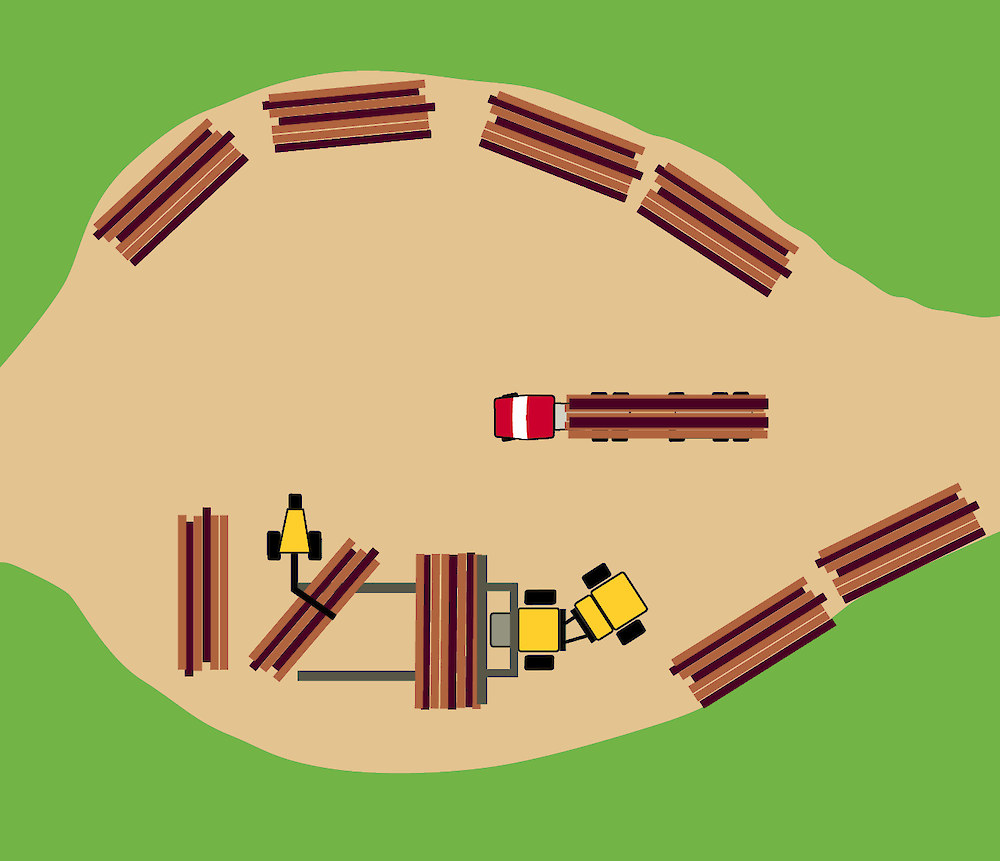The following are broad classes of landing layout. As already mentioned, their specific configuration will depend on many factors.
 Aerial view, together with a schematic diagram (below), of a drive-through landingDrive-through landing
Aerial view, together with a schematic diagram (below), of a drive-through landingDrive-through landing
Drive-through landings use a loop road to allow trucks to enter the landing from one end, continue through the middle of the landing and leave via the other end. This reduces the area required for truck turning circles. Logs can be stacked on both sides of the road allowing the truck to be loaded from either side.
A problem with drive-through landings is that the road section passing through the landing can rapidly become contaminated with mud and debris from the logging operation. Extraction, sorting and fleeting activities across the road can also lead to localised road failure. Drive-through landings are best suited for small settings harvested in drier times of the year.
Drive-through landings
Roadside landing
Roadside landings are very similar to drive-through landings. However, the landing is positioned to one side of the road only. The main disadvantage of this design is that trucks can be loaded from only one side. As stacks are harder to reach, it is most suitable when operating with a limited number of log sorts.
 Spur road landingSpur road end landing
Spur road landingSpur road end landing
Spur road end landings are used at road ends. The landings often need to be constructed larger to provide a turning area for trucks. This takes space that could otherwise be used for log stacks or processing. Alternatively, when space is constrained, logging trucks can turn at a nearby widened road section or at a road junction and can back onto the landing.
 Split-level landing with stems two-staged back to a processing siteSplit-level landing
Split-level landing with stems two-staged back to a processing siteSplit-level landing
Split-level landings are an option in steep country. The yarder is sited on the upper level, and the lower level is used as the landing and processing area. The advantages of split-level landings are that they require fewer earthworks, and their batter slopes can be shorter. This results in less visual impact and lower construction cost, plus may offer improved deflection for the yarder.
 Two-stage landingTwo-stage operations
Two-stage landingTwo-stage operations
Two-stage operations use two (or more) landings. One is used to land logs, and the other is used to process, stack and load out. Two-stage landings have become common in steep hill country where a conventional sized skid is difficult to build. De-phasing the operation typically leads to a safer work site, reduced environmental effects, lower construction costs and harvesting productivity gains. For example, utilising a landing designed for the yarder and landing the stems means that the landing (often called a pad) can be located on a small site that provides favourable yarder coverage and deflection without major earthworks. The wood is then two-staged to a larger processing landing where there is more room available to sort, stack and load. It also eliminates processing under yarder ropes. Two-stage operations require an additional machine’ such as a skidder, forwarder or stems truck, to move the logs from the landing to the processing area.